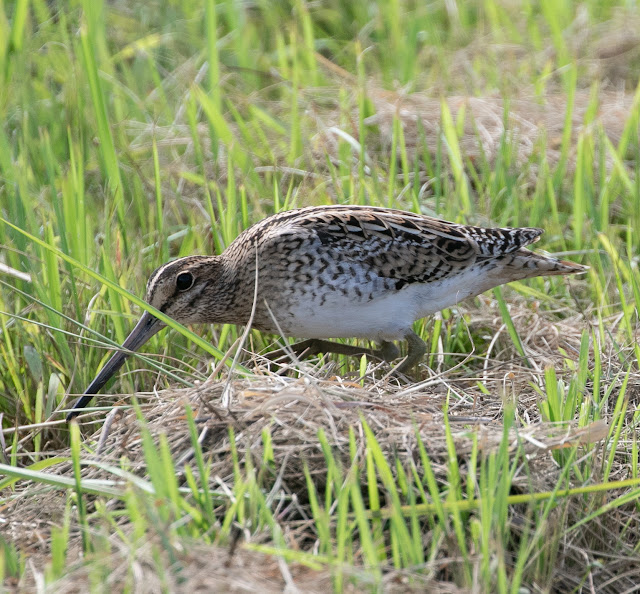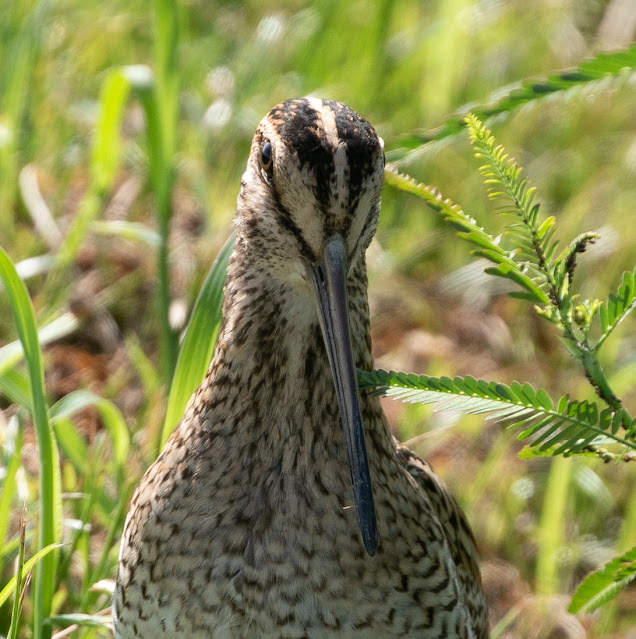Of the three snipe species in the title, Latham's and Swinhoe's are clearly the commoner migrants passing through the Kansai region. However, much further south, on a recent trip to Ishigaki, six of the seven identified snipe were Pintail, suggesting they're mainly entering (and exiting) Japan to the south of Honshu. I feel fortunate to have had so many good views of all three species within a short period of time, it's been an important refresher on migrant snipe identification; there can never be too much time spent watching snipe.
I already posted shots of a Latham's seen well a couple of weeks ago, the only one of the trio passing through the region that breeds in Japan. A couple of weeks later I managed some great shots of a Swinhoe's, also in Mie Prefecture, in another of the few fields that offer both good habitat for snipe and viewing conditions.
The Swinhoe's scurried away along a muddy furrow, below the grassy bund, before I'd even pulled up to scan the field, but after 40 metres it crouched, mostly hidden, under the overhanging grass. From the views I'd had of it disappearing along the field edge it was clearly a swintail, and it had a distinct Swinhoe's feel. Knowing it was bound to re-emerge to feed before too long, I settled down to wait. Not only did it soon re-emerge but, to my surprise, made a beline back towards its original position, right where I was waiting. Ultimately it disappeared beneath the grassy field edge three metres to my right. I walked over the spot, I'd have been less than a metre from the bird, along the entire edge of the field and back, but it didn't show itself again.
 |
| After coming out hiding, it made straight towards me, I couldn't believe my luck. But views became much, much better. |
 |
| It never ceases to amaze me how much the head shape can change from one second to the next. |
 |
| It doesn't get much better than this; zero doubt about the identity now. Not the upward, warning tail flash (which it had done earlier in response to a low-flying crow), but this spread seemed to signal caution because of my close proximity, without being an overt threat. Not something I've seen before. |
 |
| The freshly moulted brownish-buff coverts seem to blend seamlessly with the similarly hued scapular fringes and the ground colour of the flanks, creating a very uniform impression. As the feathers age they become much whiter but the lack of contrast remains. |
Next, a couple of juvenile Pintail (pins seen) on Ishigaki.
 |
| A classic-looking juvenile Pintail; this is the kind of bird responsible for the notion all Pintails look short-billed, short-tailed, are dumpy, round-headed and have skinny legs. Like the bird below, the lateral crown stripes are densely flecked rusty, note the narrow, white (juvenile) scapular fringes and the very narrow parallel black 'inner fringe' between the largely rusty feather centre and the even white fringe. |
The next bird is an adult Pintail which, though not seen as well, is of interest, showing the extent of post-breeding moult before migration.
 |
| This bird spent a lot of time sunbathing, in fact I never saw it feed all afternoon, the upshot being the pins were frequently on view. |
 |
| It's another classically short-billed bird, and note how the adult also shows extensive and obvious rusty flecks in the lateral crown stripes. I've yet to see a Swinhoe's that can match this appearance. |
 |
| Still happily sunbathing and giving the opportunity to see the extent of primary moult. There are five replaced inner primaries and three retained outers, there's a corresponding degree of moult in the primary coverts. The secondaries are unmoulted. I suppose there must be a benefit in this moult strategy, though I'd have thought a long distance migration with full flight feathers would be more energy efficient. |
The following bird (in the same field as the above adult Pintail) is a Swinhoe's in my opinion, but I wasn't able to get confirmatory views of the outer tail feathers. This would be the only Swinhoe's I saw on Ishigaki, all others seen well enough to identify were Pintail.
 |
| Compared to the first Swinhoe's, this is a more faded bird, the flanks through coverts to scapular fringes are equally lacking in contrast, just paler overall. |
 |
| Almost caught the outer tail feathers here; almost but not quite. Don't be fooled by the misplaced uppertail covert masquerading as an outmost Latham's-type tail feather. What I can see of this seems to be three narrower outermost feathers, a prominent white corner (and tips to central feathers), but also a relatively broad area of white extending towards the base. There seems altogether far too much white in the outertail for a Pintail. I could be wrong, but also I could be wrong about this and it still be a Swinhoe's. |
 |
| I followed the snipe into the next field, where it, fortunately, hadn't ventured too far into the more luxuriant veg. This and the following shot are another good example of how the apparent head shape can change in the blink of an eye, and how unreliable judging structure from photographs can be. Notice how few rusty flecks there are in the lateral crown stripes, another pointer towards Swinhoe's. |
 |
| Thick, yellow legs are another point in favour of Swinhoe's. |
 |
| The aggregation of singly inconclusive features in favour of a Swinhoe's identification is making a strong case when, by way of contrast nothing is leaning towards Pintail. |


















































